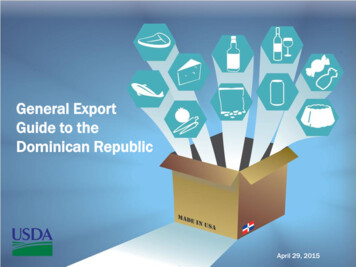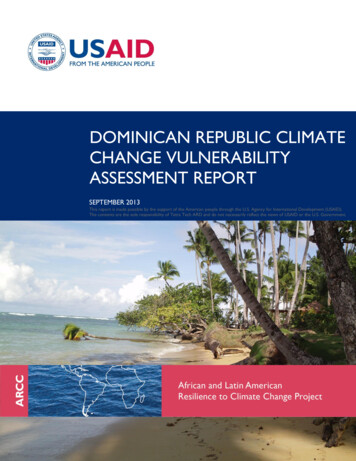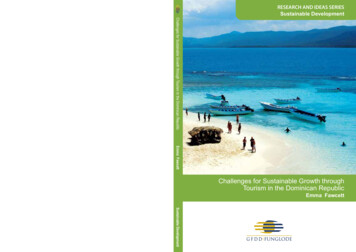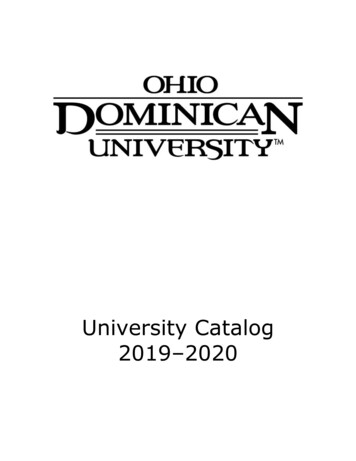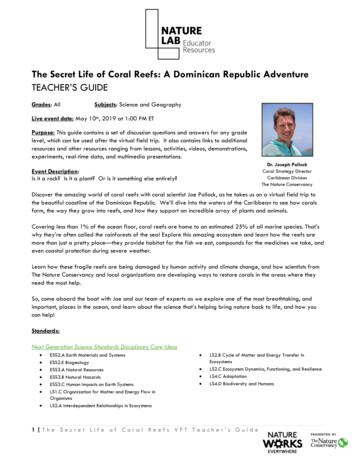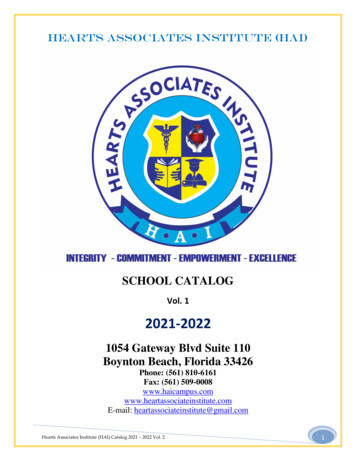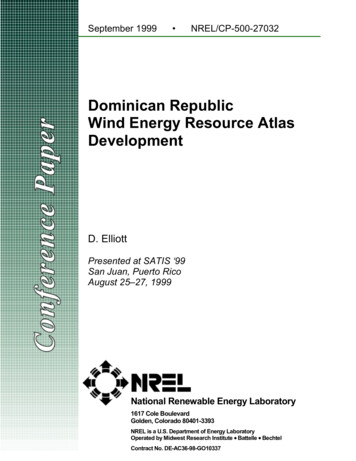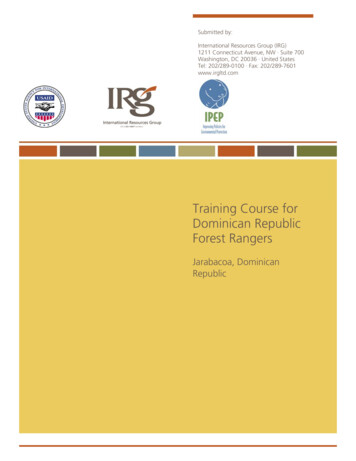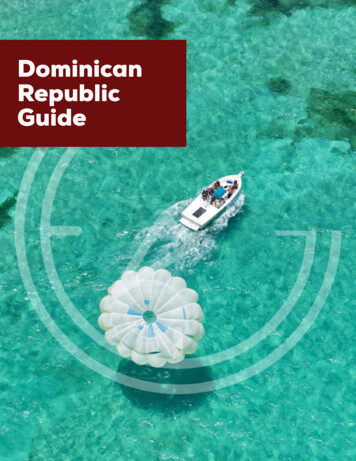
Transcription
DominicanRepublicGuide
DominicanRepublic
The Dominican Republic is located in the center ofthe Caribbean, forming part of the Greater Antilles.It shares the Island of La Española or Hispaniolawith the Republic of Haiti, occupying two thirds ofits area.Its geographical position is 68 19’ and 73 31’ Westlongitude and 17 36’ 19 59’ North latitude. Its limitsare: to the north the Atlantic Ocean, to the souththe Caribbean Sea or the Antilles, to the east theMona Channel, which separates it from the islandof Puerto Rico, and to the west is the Republic ofHaiti.The surface that the Dominican Republic occupiesis 48,511.44 km², and the area of the Keys andadjacent Islands is 159.38 km², for a total area of48,670.82 km². The main distances are from west388 kms (Cabo Engaño – Las Lajas) and north tosouth 264 kms (Cabo Beata – Cabo Isabela). Thecountry has 1,576 km of coastline and 488 km ofborder with Haiti.The surface of the Dominican Republic is 72.5%mountain range, with three large mountain systems standing out, which are the following: TheCordillera Central, which is the largest mountain system, also has the highest elevation of theAntilles Archipelago, Pico Duarte, with 3,175 meters above sea level. The northern Cordillera in thenorth separates the Atlantic Coastal Plains fromthe Cibao Valley, with Pico Diego de Ocampo beingof the highest elevation. In the Eastern Region is theCordillera Oriental, which serves as the limit to thelargest area of the country called the CaribbeanCoastal Plains.There are other minor mountain formations, suchas the Sierra de Neiba, the Sierra de Bahoruco, theSierra de Yamasa, and the Sierra de Samaná, whichis an extension of the Cordillera Septentrional,from which it is separated by the Llanos del GranEstero.The Dominican Republic has a significant numberof rivers that serve for agriculture and supply drinking water to the main cities. The most importantare Camú, San Juan, Aminas, Soco, Mao, Yaquédel Norte, Yaqué del Sur, Yuna, Artibonito, Ozama,Higuana, Nizao and Haina. With the exception ofthe Ozama River, they are only navigable by smallflat-bottomed boats. Lake Enriquillo is the largestin the Antilles, it is located between the Sierras deNeiba Bahoruco and is 43 meters below sea level,constituting one of the most important ecosystemson the Island. Other lake sources of importance inthe country are: Rincón or Cabral Lagoon, OviedoLagoon, and the Redonda and Limón Lagoons inthe Seibo Province.3
EntryRequirements4
The majority of visitors who arrive in theDominican Republic by air, including those whocome from the United States, Canada, theUnited Kingdom, the European Union, Russia,Ukraine, Kazakhstan, Mexico, many countriesin South America, Central America, Japan,Israel, etc., do not need a visa to enter thecountry. The cost of the tourist card that waspreviously paid separately is already includedin the price of the air ticket. Every foreign citizen who enters the Dominican Republic, exclusively for tourist purposes, must have a validpassport during their stay and departure fromthe country. This exceptional measure is validuntil July 31, 2022.Presentation of vaccination cards upon arrivalin the Dominican RepublicIn accordance with the protocols approved bythe Civil Aviation Board within the frameworkof its powers, the presentation of vaccinationcards will NOT be required from passengersarriving in the Dominican Republic.Entrance to hotels, hotel complexes and services offered within themTo enter the hotels and services offered withinthem and the hotel complexes, the presentation of the vaccination card against COVID-19will not be necessary, nor will the negative PCRtest be required, taking into account the application of strict protocols of risk managementpreviously approved for the sector.All airports and tourist activities in theDominican Republic are open to the public, aswell as ports, marinas and anchorages to receive yachts, ferries and cruise ships.5
E-TiketThe Dominican Republic adopted an electronic system providing digital versions ofthe Traveler’s Health Affidavit, CustomsDeclaration and International Embarkation/Disembarkation forms, combined in a singledigital form. All passengers entering and departing the country on commercial flights willbe required to fill out and submit their digitalforms through the Electronic Ticket Portal either before or upon their arrival to the country.To save time during the arrival procedure, werecommend filling out the form 72 hours before the trip, printing or making a screenshot ofthe QR code and keeping it on hand until arrival, where it will be scanned by the authoritieswhen the passenger goes through Customs.Passengers will need to fill out a form for arrival and another one for departure and thesystem will generate two QR codes. The QRcode will not be scanned during departure, butit is a confirmation that the form was completed correctly. If you need to make a change tothe form, in the E-ticket portal you can selectthe option to consult the issued E-ticket, enterthe application code of the form and make thenecessary changes.Dominican airports have free internet access,so that passengers who did not fill out the formbefore flying can do so when they arrive in thecountry. For additional information and towatch an instructional video, please visit: iving on private flights, non-commercialvessels, ferries, cruise ships, etc., do not needto fill out the electronic form.The physical Traveler’s Health Affidavit,Customs Declaration and InternationalEmbarkation/Disembarkation forms will beaccepted for the aforementioned passengers.6Stay ExtensionIf you stay more than 30 days, you will haveto pay an additional fee when you leave thecountry, which will be determined by the total duration of your stay. Find the applicablefees and upload the required documents here, which you will need to pay for online beforeyour departure or at the migration section atthe airport after check-in and after passingthrough security. There is also a US 20 departure tax required by law, but it is includedin the airfare.VisasThe Dominican Republic issues tourist, business, work, student and residence visas.Tourist visas can be issued for single or multiple entries. Anyone, regardless of their nationality, can visit the Dominican Republic ifthey are a legal resident of or have one of thefollowing valid visas in their passport: UnitedStates, Canada, United Kingdom, or Schengen.Travelers who do not have a passport or visafrom the countries mentioned above or fromother authorized countries, will need to applyfor a visa. To issue a visa, the passport must bevalid for at least six (6) months.
Who is exempt fromneeding a visa?Residents in the Dominican Republic andDominican nationals.Diplomatic and consular personnel withassigned missions in the country, while theyremain in service.Passengers using non-commercial privateaviation as long as the aircraft meets thefollowing requirements: the trip must befor sports, leisure, tourism and businesspurposes, and the aircraft must not weighmore than thirty thousand (30,000) poundsand have a maximum capacity of 12 passengers.See list of Dominican consulates abroad here.Be sure to always check for up-to-date requirements before you travel.CustomsThe following items are allowed to be broughtinto the Dominican Republic:1. A maximum of 20 packs of cigarettes, 25cigars or 200 grams of tobacco.2. Up to three (3) total liters of wine, beer,rum, whiskey or liquor.3. Gifts worth up to US 500 (five hundredUS dollars) once every three months.4. Medications for personal use in quantitiesthat justify the exclusive use of the passenger. In the case of medications that containpsychotropic substances, you must presentthe medical prescription that supports theiruse.Click here for more information.7
AirEntry8
The Dominican Republic has 8 internationalairports, 5 cruise destinations, a variety ofmarinas for boats and yachts, and domesticrunways for private planes and charter flights.Whatever your destination in the DominicanRepublic, whether by sea or air, choosing theright point of entry is very important. It is a large island, with roads whose distances sometimes cannot be covered in a single day. Forexample, traveling by land between the PuntaCana and Puerto Plata airports can take up toseven hours. Therefore, choosing your point ofentry and exit, according to your final destination on the island, is crucial, and will save youmoney and time.9
International Airports:Santo DomingoLas Américas International Airport (SDQ)–also known as José Francisco Peña GómezInternational Airport–is located 30 minutesfrom the capital of Santo Domingo, and is thecity’s main point of entry for international airarrivals. SDQ is also convenient to the touristbeach towns of Boca Chica and Juan Dolio,starting just six miles away.La Isabela International Airport (JBQ)–alsoknown as Dr. Joaquín Balaguer InternationalAirport– is located north of Santo Domingo,and handles flights to Haiti, Cuba, and selectneighboring Caribbean islands.Punta CanaPunta Cana International Airport (PUJ), is a15-minute drive from the Punta Cana and CapCana areas, a 30-minute drive from Bávaro, ElCortecito, and Arena Gorda, and a 45-minutedrive from the Macao and Uvero Alto areas.Offering direct flights from over 28 countriesand 96 cities around the world, this is the busiest airport in the Dominican Republic andthe second busiest in the Caribbean region,with nearly 3.5 million international passengerarrivals every year.10Puerto PlataGregorio Luperón International Airport(POP) is conveniently located 20 minutesfrom the north coast city of Puerto Plata, andnear neighboring tourist destinations such asCofresí, Playa Dorada, Sosúa, and Cabarete.It is also convenient to Playa Grande and RíoSan Juan, an hour away by road.La RomanaLa Romana International Airport (LRM), alsoknown as the Casa de Campo InternationalAirport–is strategically located on the southeastern coast, a mere 10-minute drive fromCasa de Campo Resort & Villas, and a 20-minute drive from Bayahibe. The airport is alsoless than two hours’ drive from Santo Domingo, and less than an hour’s ride from PuntaCana.
SamanáEl Catey International Airport (AZS)– también conocido como Aeropuerto InternacionalJuan Bosch, se encuentra a media hora de laciudad de Santa Bárbara de Samaná, a media hora de Las Terrenas y a solo una hora deLas Galeras.SantiagoCibao International Airport (STI) is 15 minutes from bustling Santiago, the second largestcity in the Dominican Republic, tucked in themountainous center of the country. It is closest to the nearby cities and towns of La Vega,Jarabacoa, and Constanza. It can also be asecond gateway option if you are staying inPuerto Plata–just ensure additional transportation time before your return flight.11
Climate12
Thanks to its location in the Caribbean, theDominican Republic is a destination withsunshine all year round. Whether in high-altitude regions or in cities, it’s rare not to seeblue skies during the day. Being surrounded bymore than 1,600 km of coastline to the north, east and south, and the climate is tropical.Temperatures range between 27 C and 32 CThe months of December through earlyMarch, which coincide with the coldest wintersin North America and Europe, have the mostpleasant weather in the Dominican Republic.Mornings and evenings feature cool breezesand temperatures as low as 18 C, while daytime temperatures range from 25 C to 27 C. Inthe mountainous areas of the country, such asJarabacoa and Constanza, temperatures candrop even lower, with days starting at 10 Cand some nights below zero degrees.Summer is the hottest and rainiest season inthe country, while the humidity is more intense from April to October. Temperatures hover around 32 C at the peak of the day, andstorms are more frequent but short-lived.Because we are in the tropics, it is difficult tosay if and when there is a rainy season.13
HurricaneseasonThe official Atlantic hurricane season runsfrom June 1 to November 30, with Septemberbeing the busiest. The Dominican Republic iswithin the storm area, but the chances of amajor hurricane making landfall are slim. In thelast century only 11 hurricanes have reachedthe Dominican Republic. On the slim chancethat any kind of tropical storm is on the way,hotels and airlines are always well informedand prepared, and you’ll have plenty of timeto adjust your plans.In the last two years, climate change hastaken its toll on the Caribbean region, andthe Dominican Republic has not been spared.There are hotter days than in the past, andMother Nature has been more unpredictable.But one thing is for sure: the sun always risesin the Dominican Republic.14
15
Language16
The official language of the DominicanRepublic is Spanish; and like many of theirLatino counterparts, Dominicans have theirown accent, colloquialisms, and idioms. Theyare particularly famous for speaking incredibly quickly, mouthing words at a mile a minute.They abbreviate, omit syllables and do notpronounce certain letters, such as the plural“s” (for example, they say La Terrena when referring to Las Terrenas).Not knowing Spanish is not a problem: Englishis widely spoken in tourist areas. Tour guidesand hotel staff in the different regions arealso well-versed in multiple languages, including Italian, French, German, Russian, amongothers.The Dominican people are very friendly; Thatis why, if you come across people who do notspeak your language, they will surely makesure to help you find someone who can assistyou.17
Money18
The local currency is the Dominican Peso(RD ). The exchange rate fluctuates depending on the day and location of the exchangepoint.Keep these ballpark numbers in mind as a general guide:RD 100 US 2RD 500 US 10RD 1,000 US 20Businesses in tourist destinations, includingrestaurants, bars, department stores, souvenir shops and supermarkets tend to acceptdollars, although you will receive a less favorable rate than in banks. That said, most pricesin the Dominican Republic are in Dominicanpesos. If you plan to make a large purchasefrom small shops and markets, first negotiatewith the seller who may be interested in receiving payment in US dollars or euros. However,prices are fixed in supermarkets and in storesin shopping malls. The best option is to use anATM to withdraw in local currency at the bestdaily exchange rate.You’ll find ATMs at a variety of banks, includingScotiabank and Banco Popular. These are safe to use and make withdrawals in the localcurrency, they will also offer you the best exchange rates. Please choose indoor ATM andadhere to daytime use. If you need help determining the amount you want to withdraw,download and use a free app like XE.US dollars and euros can be easily exchanged at banks or authorized exchange offices throughout the country. Some exchangehouses also accept the following currencies:Canadian dollar, Swiss franc, Danish krone,British pound, Japanese yen, Scottish pound,Swedish krona and Norwegian krone.Banks close at 5 P.M. on weekdays, but mostbranches inside shopping malls stay open until around 7-8 P.M. ATMs are available in supermarkets and shopping malls until later. Forsecurity reasons, it is better to use exchangeservices or withdraw money from ATMs alongthe trip. ATMs offer a menu in English orSpanish.19
Is it better to changemoney at the airport?The only advantage is the convenience to payfor your airport taxi and your first transactions. Otherwise, if you must change money,go to one of the main banks in the DominicanRepublic: they use the daily exchange rate ofthe Central Bank as a reference point for exchange transactions, so the difference in theexchange rate between banks is insignificant.TipsRestaurant bills include a 10% service charge,plus 18% sales tax that you’ll see listed as ITBIS.It is customary and good practice to leave anadditional 10% to ensure that the waiter receives a tip.Taxis do not typically take tips, but if you feelyou received exceptional service or had a specific situation where the driver helped you, feelfree to reward the service.20
21
ImportantData22
What to pack?Packing to travel to the Dominican Republicmeans carrying an assortment of clothes,tailored to your chosen destination. Bringyour bathing suits, long cotton sleeves to protect yourself from the sun, and shorts for thebeach, but also pack casual daytime clothesfor visits to the city, and avoid wearing shortsin Santo Domingo, or to enter places of interest. Please note that walking in a bathing suitis acceptable on the beach, near the pool or inthe outdoor areas of your resort, but not in thestreets, supermarkets or restaurants.Dominicans dress well and keep their appearance neat at all times, especially when theygo out in the evenings. Pack a couple of dressier outfits for dinner and nightlife. If you’restaying in Santo Domingo, bring your regularcity clothes, as well as a couple of fancy options. If you are going to a performance at theNational Theater, you will need a jacket; andjeans are not allowed. Also, if you are visitingchurches or certain national monuments andmuseums, you may not be able to enter if youare in shorts or miniskirts. Some governmentoffices do not allow you to enter with a sleeveless shirt or not closed shoes.If you visit the mountain towns of Jarabacoaand Constanza, or even the hills of PuertoPlata, you will need long sleeves, a jacket andpants to protect you on excursions, but alsobecause the temperatures are lower in theseplaces; It’s cold at night and in the morning.Aside from clothing, don’t forget to bringany prescription medications, your preferredbrands of sunscreen (limited options are available here), a hat, sunglasses, and mosquitorepellant. If you’ll be spending significant timetraveling to the countryside, bring a book ortwo and your headphones.The Dominican Republic is a modern destination, and you will find everything you need inthe many shopping centers in the center of themain cities of the country, from toy stores toclothing stores, pharmacies and supermarkets. Remember that imported items will cost23
more than in their country of origin.ElectricityLa yin theenDominicanruns funcionasignificafromque loson110 convolts.110Thisvoltios.meansEstothat visitorsvisitantesprocedentesdeEstadosUnidosthe United States and Canada do not need yCanadá nonecesitanadaptadoresy podránadaptersandwill be ableto plug directlyintoconectarsedirectamentea lastomasde cotheoutlets. TravelerscomingfromEuroperriente.viajerosvienende Europaor otherLosregionsthat queoperateon 220volts uotrasregionesqueadaptersoperan convoltios newillneedto bringand220converters.cesitarán largertraer adaptadoresy convertidores.Althoughresorts have someon handAunquelos desk,resortsalguatthe frontit’smásbestgrandesto bringtienenyour owntonos a manoen la recepción, es mejor traer losavoiddisappointment.tuyos para evitar decepciones.The main resorts have generators to dealLosresortswith principalesany blackoutsin thecuentanstreet. Ifconyou generastaydores parahacer frenteaacualquierapagónoutsidethe touristareas, insmall hotelor inen lacountryside,calle. Si te alojasfuerathatde laszonasturísthebe enfrequent irregularities and power surges. Thisen cuentapuedehaberfrecuentesirremeansyou ridades y sobrecargas de energía. Estosignifica que debes proteger tus aparatoselectrónicos, a menos que tengan un protector contra sobrecargas incorporado.The telephone country code is 1. There arethree area codes: 809, 829, and 849.Like its infrastructure, the DominicanRepublic’s telecommunications services areamong the most complete and advanced inthe Caribbean, from local cell phone service toInternet access options. The two largest andbest-known communications providers in thecountry are Claro and Altice.The cheapest way to keep in touch and makecalls while in the Dominican Republic, espe-24cially on a long trip, is to have your own phone number. If your cell phone is in the GSMnetwork, you can use it. However, roamingcosts will be high. The best option is to bringan unlocked phone and buy a SIM card hereto have a local number; you can get one withyour passport or ID and activate it at any ofthe local telecommunications companies. Goto a Claro or Altice branch, sometimes inside amall or supermarket, and buy a new SIM cardfor less than US 5. This usually includes tenminutes of free local calls. You must bring:&An unlocked cell phone or smartphone;A valid passport, legally required to obtaina SIM card.Once you have a phone and a working phone number, you can top up your credit in anyamount you choose throughout the country.Telephone credits are also available throughBanca booths (betting and lottery locals) located throughout the country. You simply givethem your number, and indicate the amountyou would like to top up.Wi-Fi access is very common in the DominicanRepublic. You will find it inside cafes, restaurants, large bus stations and hotel lobbies.Don’t expect high speed or consistency at alltimes, but it’s generally enough for checkingemail and doing basic errands.If you need faster service and access anywhere in the country, even in the countryside, consider buying a mobile internet device for about 55-60 from a phone company. You will needyour passport to make the purchase. You canthen top up the device as needed by weeklypack or by GB.Si necesitas un servicio y acceso más rápido en cualquier parte del país, incluso en elcampo, considera la posibilidad de comprarun dispositivo de Internet móvil por aproximadamente US 55-60 a una compañía telefónica. Necesitarás tu pasaporte para realizarla compra. A continuación, puedes recargar eldispositivo según sea necesario por paquetesemanal o por GB.
INFOShopping HoursMost businesses work from 8:30 AM-9:00A.M. to 5:00 PM-6:00 P.M. on weekdays; until1:00 P.M. on Saturday afternoons and closedon Sundays. In the cities, large shopping centers and supermarkets are an exception: theyclose at 9:00 P.M. on weekdays and open onSundays from 9:00 A.M. to 8:00 P.M.Restaurants generally stay open and servefood until 10:00 P.M. – 12:00 A.M., Sundaythrough Thursday, and until 2:00 A.M. onFridays and Saturdays. Holidays have a special schedule; be sure to check each establishment’s policy on their website or social mediapages.HolidaysThe Dominican Republic celebrates 12 officialholidays. The most important are Easter andChristmas.1 of January New YearJanuary 6: Three Kings DayJanuary 21: Day of Our Lady of La Altagracia (Patron Saint of the Dominican Republic)January 26: Juan Pablo Duarte DayFebruary 27: Independence DayApril 10: Good Friday (Easter)May 1: Labor DayJune 11: Corpus Christi DayAugust 16: Restoration of IndependenceDaySeptember 24: Day of Our Lady of MercedesNovember 6: Constitution DayDecember 25: Christmas Day25
Health andSecurity26
WaterThe tap water is not drinkable, and you shouldnot drink the shower water either. To drink, buybottled water at all times. Hotels often providea couple of free bottles a day for each room,or have dispenser purified bottled water available for guests to use. In local Colmados orcorner stores, and supermarkets you can easily buy drinking water.Sun ProtectionThe sun is very strong in the Caribbean, evenon cloudy days. Whether you’re at the beach,on a boat trip, or walking around town, makesure to wear sunscreen at all times. It is bestto bring your favorite brand. Although you willbe able to buy sunscreen in the country, youmay not find the brand you prefer and it will bemore expensive at souvenir shops and resorts.When you go on a hike, to the beach at sunset,or stay in the country, use mosquito repellantto prevent bites.Personal SecurityYou must apply common sense rules whentraveling in the Dominican Republic, as inany other destination.Store your passport and valuables in thehotel safe. Keep a smaller form of identification or a copy of your passport with you.Don’t wear expensive jewelry and leaveall your valuables at home. When walkingaround big cities, dress like a local and knowwhere you’re going.In non-tourist areas use your cell phonediscreetly, putting it away after taking yourphotos.27
Carry local currency in cash in limited portions; only what you need during the day. Ifyou have a credit card, take it with you incase of an emergency.At night, avoid walking alone in isolatedareas. Go out in groups and use an assigned taxi, recommended by your hotel, totransport you. You should also avoid drivingat night, even on main roads; plan your roadtrips for the day.If you rent a vehicle, do not leave any valuables in the car in plain sight, even if you seea security guard on site.Medical LaboratoriesThe Dominican Republic has multiple chainsof laboratories where specialized testssuch as Hematology, Clinical Chemistry,Urinalysis and Parasitology, ImmunologySerology, Immunofluorescence, Microbiology,Electrophoresis and Special Tests can be performed. Among the main ones are LaboratorioClínico Amadita, Laboratorio de Referencia yLaboratorio Clínico Lic. Patria Rivas.Stay in busy, well-lit areas.Learn some Spanish words and phrases,especially for asking directions.Medical Care andEmergenciesTourist areas and cities are equipped to offermodern medical care, with private hospitals,clinics and qualified personnel to treat patients of all ages.For emergencies, including ambulance, firefighters and police, dial 911. You can also contact the CESTUR office (Specialized TouristSecurity Corps), which is trained and specializes in offering assistance to visitors. If you arethe victim of a crime, CESTUR agents will helpyou file a complaint and seek any other type ofhelp that is necessaryPharmacyThe Dominican Republic has multiple chains oflaboratories where all kinds of medicines andbasic health needs can be obtained. Somemajor chains are Farma Xtra, Farmacia Carol,FarmaValue y Farmacia Los Hidalgos.COVID-19As of February 16, 2022, all the restrictivemeasures imposed by COVID-19 are suspended, and each individual will be responsible fortaking their own measures to safeguard theirhealth, responsibly, but without restrictions.Measures such as the use of the mask, thepresentation of the vaccination card to accessplaces of public use or the restrictions in publicspaces are the responsibility of each individual.100% of the staff in the tourism sector (hotels,airports, restaurants, transportation, etc.) have been vaccinated with two doses, and arein the process of being vaccinated with a thirdand fourth dose of the COVID-19 vaccine.The Dominican Republic has a robust healthsystem that has been able to identify the casespresent in the country. For more informationon COVID-19 in the Dominican Republic, please go to the website of the Ministry of Public28
Health (https://www.msp.gob.do/web/) or download the COVID-RD mobile application, availableat the App Store and Google Play, which works likea passport for tourists with which, through a QRcode, the visitor can report their condition and have access to a series of services and information.29
Groundtransportation30
The Dominican Republic has an extensiveroad network, most of which are in good to faircondition. The main ones are: The AutopistaDuarte, which is the largest and most important, connects the city of Santo Domingowith the provinces of the northern region; theAutopista de Las Américas and the Autovía delEste, which connect the city of Santo Domingowith the entire region-Southeast; and theAutopista Sánchez, which communicates withthe entire Southwest and West Regions.The main means of intercity transport is thebus, the price of these varies depending onthe distance. There are a good number ofcompanies with daily departures from SantoDomingo to the main cities of the country.There are also bus routes to Port-au-Prince,the capital of the Republic of Haiti. Among themain companies that offer intercity passengertransport services are: Transporte Espinal,Grupo La Noel, Caribe Tours, Autobuses Metro,Servitur, APTPRA y Expreso Bávaro.In the city of Santo Domingo, the most widespread means of transport is the bus or minibus, popularly called guagua, generally with26 passengers, but the custom is to ride fiveper seat, which means seating five people perrow of seats. It is best to use the large-capacity state buses, known as the OMSA, for theacronym for Metropolitan Bus Service Office.The Santo Domingo Metro is a rapid transitsystem in Greater Santo Domingo. Serving thecapital of the Dominican Republic, it is the mostextensive metro system and the second oldestin the insular Caribbean region and CentralAmerica by length and number of stations.You can get information about the stops andthe best places in the city of Santo Domingoby traveling by metro in Metro Santo Domingo.Other means of transportation are the so-called concho cars, which carry out short routeswithin the city, and the motoconchos, motorcycles that transport to places where thereare no routes or are difficult to access. It isrecommended to request the cost of transportation before starting the route and to negotiate with the drivers.Like any other country, the Dominican Republic31
has taxi services in demand. The use of applications such as UBER and DIDI is very commonin Santo Domingo and in some tourist cities.Another way to travel is by renting a car.Foreign driver’s licenses or permits are validonly for the duration of your legal stay, that is,up to 30 days or the term of your visa.In the Dominican Republic the way to drive ison the right, the maximum speed on highwaysis 80 Kph, in suburban areas 60 Kph and incities 25-35 Kph, unless a sign indicatesotherwise. The infraction of traffic signals canbe punished with imprisonment
The surface that the Dominican Republic occupies adjacent Islands is 159.38 km², for a total area of 388 kms (Cabo Engaño - Las Lajas) and north to south 264 kms (Cabo Beata - Cabo Isabela). The country has 1,576 km of coastline and 488 km of border with Haiti. The surface of the Dominican Republic is 72.5%
